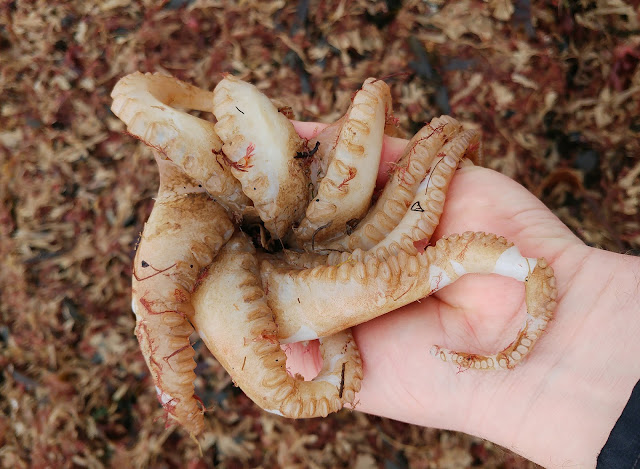Wednesday, March 7, 2018
The nature of the Beast?
As detailed in the last post, thankfully there were minimal signs of impact on marine life along my local Filey shoreline after the recent extreme conditions; after hearing about the extraordinary events occurring further south, however, I drove the half-hour or so down to Fraisthorpe (just south of Bridlington) to see for myself, and it was an illuminating and jaw-dropping few hours to say the least.
It was a scene of devastation the likes of which I've never seen before, and having spoken to various locals, the worst of its kind in at least 20 years; almost surreal in its sheer extent and volume, the thick carpet of perished marine animals was so extensive as to be a multi-coloured blur, ankle deep in places and stretching as far as the eye could see. Of the creatures involved, well, there was pretty much everything; in that sense, it was at least hugely educational and fascinating to observe so many incredible species up close, albeit in less than thriving circumstances.
I walked a high-tide transect from Fraisthorpe to Barmston along the top of the beach (about 4km) counting stranded birds, of which there were 19 Guillemots, six Woodcocks, a Snipe, a Kittiwake and two young Great Black-backed Gulls; due to the conditions I no doubt missed a few, especially of the more cryptic species. On the way back north, I walked a mid-tide transect often through ankle-deep detritus, and I doubtless missed the vast majority - at one point I crouched down to photograph a fish and noted not one but two Guillemots otherwise obscured within just a few metres.
Most depressing of all, however, was the sheer volume of human-made waste - most of it plastic, and much of it industrial. While there were hundreds upon hundreds of plastic drinks bottles and containers, plus every other conceivable piece of 'disposal' crap from the high street, it was nothing compared with the many tonnes of industrial waste dredged from a seabed clearly heaving with many decades of accumulation. It was impossible to take a few paces without tripping on or having to avoid everything from lobster pots, tyres, strapping, weights, buoys, netting, trash and rubber gloves; of the latter, there were hundreds, all set to live long in this increasingly fragile ecosystem for hundreds, if not thousands of years.
It's easy to shrug it off as a freakish natural event, but it's a fact of life now that extreme meteorological occurrences are becoming more routine and commonplace (and we all know why). Likewise, while it may not be the most pleasant sight (or smell), the biodegrading of marine life washed ashore - from Porpoise and Guillemots to the tiniest organisms - is ultimately an integral and essential part of the marine ecosystem's life-cycle. As for the human-made waste? Nowhere fast.
The team at YWT Living Seas Centre (which I'm happy to be part of again this year) are organising beach cleans over the coming days, and if you have a couple of hours to spare, it'd be a great way to make a difference - have a look at their schedule here.





































